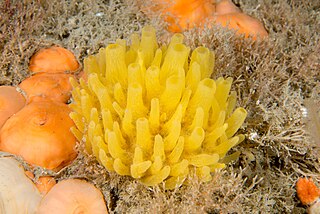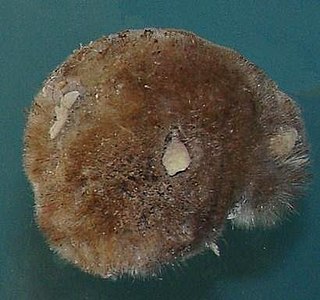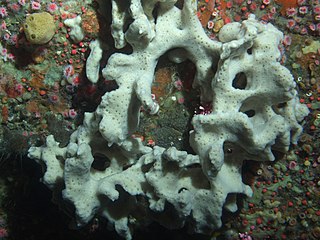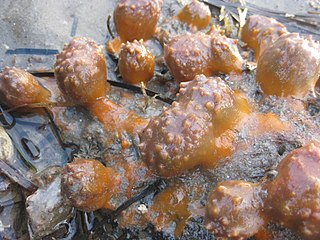
Demosponges (Demospongiae) are the most diverse class in the phylum Porifera. They include 76.2% of all species of sponges with nearly 8,800 species worldwide. They are sponges with a soft body that covers a hard, often massive skeleton made of calcium carbonate, either aragonite or calcite. They are predominantly leuconoid in structure. Their "skeletons" are made of spicules consisting of fibers of the protein spongin, the mineral silica, or both. Where spicules of silica are present, they have a different shape from those in the otherwise similar glass sponges. Some species, in particular from the Antarctic, obtain the silica for spicule building from the ingestion of siliceous diatoms.

Polymastia is a genus of sea sponges containing about 30 species. These are small to large encrusting or dome-shaped sponges with a smooth surface having many teat-shaped projections (papillae). In areas of strong wave action, this genus does not grow the teat structures, but instead grows in a corrugated form.

Polymastiidae is a family of demosponges found in oceans throughout the world. It is the only family in the monotypic order Polymastiida. A useful diagnostic characteristic of members of this family is the presence of numerous surface papillae although this feature is shown by some other sponges.
Tylexocladus is a genus of deep-water sea sponge belonging to the family Polymastiidae. These are small rounded sponges with a bristly surface bearing one or more raised openings.
Acanthopolymastia is a small genus of demosponges belonging to the family Polymastiidae. It has three describe species. These small, bristly, cushion-shaped sponges are only known from deep-sea sites in the southern oceans.
Polymastia aurantia is a species of sea sponge belonging to the family Polymastiidae. It is found in intertidal habitats including tide pools in the vicinity of Auckland, New Zealand.

Spongia is a genus of marine sponges in the family Spongiidae, originally described by Carl Linnaeus in 1759, containing more than 60 species. Some species, including Spongia officinalis, are used as cleaning tools, but have mostly been replaced in that use by synthetic or plant material.

Tethya is a genus of sea sponges belonging to the family Tethyidae. Members of this genus all have a spherical body form and some are known to be able to move at speeds of between 1 and 4 mm per day.

Ircinia is a genus of sea sponges in the family Irciniidae.
Dictyodendrillidae is a family of sponges in the order Dendroceratida.

Ianthella basta is a species of fan-shaped sea sponge in the class Demospongiae. It is also known as the elephant ear sponge, paper sponge, or scroll sponge.

Aaptos is a genus of sea sponges in the family Suberitidae.
Aaptos conferta is a species of sea sponge belonging to the family Suberitidae and is found in New Zealand. The species was described in 1994 by Michelle Kelly-Borges & Patricia Bergquist.

Aaptos tentum is a species of sea sponge belonging to the family Suberitidae. The species was described in 1994 by Michelle Kelly-Borges and Patricia Bergquist.
Citronia is a genus of sea sponges in the family Dysideidae. It consists of one species, Citronia vasiformis(Bergquist, 1995).
Cymbastela coralliophila is a species of marine sponge in the family Axinellidae.
Suberea is a genus of sponges belonging to the family Aplysinellidae.
Atergia is a genus of sponges belonging to the family Polymastiidae.

Latrunculia is a genus of demosponges. It is well known for the diverse array of chemical compounds found in its species, including the latrunculins, which are named after this genus. Many of these are medically important, including anti-cancer compounds such as discorhabdins.
Michelle Kelly, also known as Michelle Kelly-Borges, is a New Zealand scientist who specialises in sponges, their chemistry, their evolution, taxonomy, systematics, and ecology.









